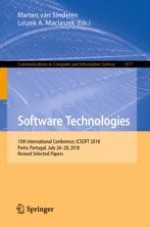2019 | Buch
Software Technologies
13th International Conference, ICSOFT 2018, Porto, Portugal, July 26-28, 2018, Revised Selected Papers
herausgegeben von: Dr. Marten van Sinderen, Prof. Leszek A. Maciaszek
Verlag: Springer International Publishing
Buchreihe : Communications in Computer and Information Science
